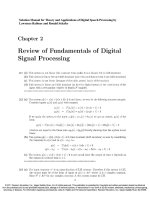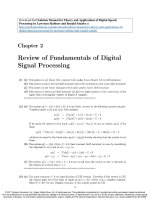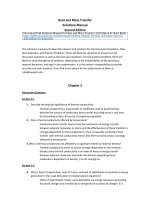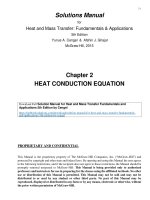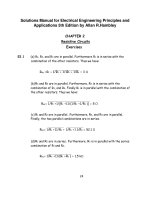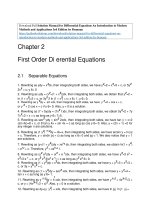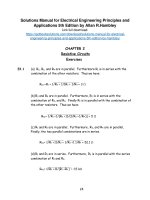Solution manual for heat and mass transfer fundamentals and applications 5th edition by cengel
Bạn đang xem bản rút gọn của tài liệu. Xem và tải ngay bản đầy đủ của tài liệu tại đây (4.96 MB, 128 trang )
2-1
Solutions Manual
for
Heat and Mass Transfer: Fundamentals & Applications
5th Edition
Yunus A. Cengel & Afshin J. Ghajar
McGraw-Hill, 2015
Chapter 2
HEAT CONDUCTION EQUATION
Download Full Solution Manual for Heat and Mass Transfer Fundamentals and
Applications 5th Edition by Cengel
/>
PROPRIETARY AND CONFIDENTIAL
This Manual is the proprietary property of The McGraw-Hill Companies, Inc. (“McGraw-Hill”) and
protected by copyright and other state and federal laws. By opening and using this Manual the user agrees
to the following restrictions, and if the recipient does not agree to these restrictions, the Manual should be
promptly returned unopened to McGraw-Hill: This Manual is being provided only to authorized
professors and instructors for use in preparing for the classes using the affiliated textbook. No other
use or distribution of this Manual is permitted. This Manual may not be sold and may not be
distributed to or used by any student or other third party. No part of this Manual may be
reproduced, displayed or distributed in any form or by any means, electronic or otherwise, without
the prior written permission of McGraw-Hill.
PROPRIETARY MATERIAL. © 2015 The McGraw-Hill Companies, Inc. Limited distribution permitted only to teachers and educators for course
preparation. If you are a student using this Manual, you are using it without permission.
2-2
Introduction
2-1C The term steady implies no change with time at any point within the medium while transient implies variation with time
or time dependence. Therefore, the temperature or heat flux remains unchanged with time during steady heat transfer through a
medium at any location although both quantities may vary from one location to another. During transient heat transfer, the
temperature and heat flux may vary with time as well as location. Heat transfer is one-dimensional if it occurs primarily in one
direction. It is two-dimensional if heat tranfer in the third dimension is negligible.
2-2C Heat transfer is a vector quantity since it has direction as well as magnitude. Therefore, we must specify both direction
and magnitude in order to describe heat transfer completely at a point. Temperature, on the other hand, is a scalar quantity.
2-3C Yes, the heat flux vector at a point P on an isothermal surface of a medium has to be perpendicular to the surface at
that point.
2-4C Isotropic materials have the same properties in all directions, and we do not need to be concerned about the variation
of properties with direction for such materials. The properties of anisotropic materials such as the fibrous or composite
materials, however, may change with direction.
2-5C In heat conduction analysis, the conversion of electrical, chemical, or nuclear energy into heat (or thermal) energy
in solids is called heat generation.
2-6C The phrase “thermal energy generation” is equivalent to “heat generation,” and they are used interchangeably. They
imply the conversion of some other form of energy into thermal energy. The phrase “energy generation,” however, is
vague since the form of energy generated is not clear.
2-7C The heat transfer process from the kitchen air to the refrigerated space is
transient in nature since the thermal conditions in the kitchen and the
refrigerator, in general, change with time. However, we would analyze this
problem as a steady heat transfer problem under the worst anticipated conditions
such as the lowest thermostat setting for the refrigerated space, and the
anticipated highest temperature in the kitchen (the so-called design conditions).
If the compressor is large enough to keep the refrigerated space at the desired
temperature setting under the presumed worst conditions, then it is large enough
to do so under all conditions by cycling on and off. Heat transfer into the
refrigerated space is three-dimensional in nature since heat will be entering
through all six sides of the refrigerator. However, heat transfer through any wall
or floor takes place in the direction normal to the surface, and thus it can be
analyzed as being one-dimensional. Therefore, this problem can be simplified
greatly by considering the heat transfer to be onedimensional at each of the four
sides as well as the top and bottom sections, and then by adding the calculated
values of heat transfer at each surface.
PROPRIETARY MATERIAL. © 2015 The McGraw-Hill Companies, Inc. Limited distribution permitted only to teachers and educators for course
preparation. If you are a student using this Manual, you are using it without permission.
2-3
2-8C Heat transfer through the walls, door, and the top and bottom sections of an oven is transient in nature since the
thermal conditions in the kitchen and the oven, in general, change with time. However, we would analyze this problem as a
steady heat transfer problem under the worst anticipated conditions such as the highest temperature setting for the oven, and
the anticipated lowest temperature in the kitchen (the so called “design” conditions). If the heating element of the oven is
large enough to keep the oven at the desired temperature setting under the presumed worst conditions, then it is large
enough to do so under all conditions by cycling on and off.
Heat transfer from the oven is three-dimensional in nature since heat will be entering through all six sides of the
oven. However, heat transfer through any wall or floor takes place in the direction normal to the surface, and thus it can be
analyzed as being one-dimensional. Therefore, this problem can be simplified greatly by considering the heat transfer as
being one- dimensional at each of the four sides as well as the top and bottom sections, and then by adding the calculated
values of heat transfers at each surface.
2-9C Heat transfer to a potato in an oven can be modeled as one-dimensional since temperature differences (and thus heat
transfer) will exist in the radial direction only because of symmetry about the center point. This would be a transient heat
transfer process since the temperature at any point within the potato will change with time during cooking. Also, we would
use the spherical coordinate system to solve this problem since the entire outer surface of a spherical body can be
described by a constant value of the radius in spherical coordinates. We would place the origin at the center of the potato.
2-10C Assuming the egg to be round, heat transfer to an egg in boiling water can be modeled as one-dimensional since
temperature differences (and thus heat transfer) will primarily exist in the radial direction only because of symmetry about
the center point. This would be a transient heat transfer process since the temperature at any point within the egg will change
with time during cooking. Also, we would use the spherical coordinate system to solve this problem since the entire outer
surface of a spherical body can be described by a constant value of the radius in spherical coordinates. We would place the
origin at the center of the egg.
2-11C Heat transfer to a hot dog can be modeled as two-dimensional since temperature differences (and thus heat transfer)
will exist in the radial and axial directions (but there will be symmetry about the center line and no heat transfer in the
azimuthal direction. This would be a transient heat transfer process since the temperature at any point within the hot dog
will change with time during cooking. Also, we would use the cylindrical coordinate system to solve this problem since a
cylinder is best described in cylindrical coordinates. Also, we would place the origin somewhere on the center line, possibly
at the center of the hot dog. Heat transfer in a very long hot dog could be considered to be one-dimensional in preliminary
calculations.
2-12C Heat transfer to a roast beef in an oven would be transient since the temperature at any point within the roast will
change with time during cooking. Also, by approximating the roast as a spherical object, this heat transfer process can be
modeled as one-dimensional since temperature differences (and thus heat transfer) will primarily exist in the radial
direction because of symmetry about the center point.
2-13C Heat loss from a hot water tank in a house to the surrounding medium can be considered to be a steady heat transfer
problem. Also, it can be considered to be two-dimensional since temperature differences (and thus heat transfer) will exist
in the radial and axial directions (but there will be symmetry about the center line and no heat transfer in the azimuthal
direction.)
PROPRIETARY MATERIAL. © 2015 The McGraw-Hill Companies, Inc. Limited distribution permitted only to teachers and educators for course
preparation. If you are a student using this Manual, you are using it without permission.
2-4
2-14C Heat transfer to a canned drink can be modeled as two-dimensional since temperature differences (and thus heat
transfer) will exist in the radial and axial directions (but there will be symmetry about the center line and no heat transfer in
the azimuthal direction. This would be a transient heat transfer process since the temperature at any point within the drink
will change with time during heating. Also, we would use the cylindrical coordinate system to solve this problem since a
cylinder is best described in cylindrical coordinates. Also, we would place the origin somewhere on the center line, possibly
at the center of the bottom surface.
2-15 A certain thermopile used for heat flux meters is considered. The minimum heat flux this meter can detect is to
be determined.
Assumptions 1 Steady operating conditions exist.
Properties The thermal conductivity of kapton is given to be 0.345 W/mK.
Analysis The minimum heat flux can be determined from
t
0.1C
2
q k L (0.345 W/mC) 0.002 m 17.3 W/m
2-16 The rate of heat generation per unit volume in a stainless steel plate is given. The heat flux on the surface of the plate
is to be determined.
Assumptions Heat is generated uniformly in steel plate.
Analysis We consider a unit surface area of 1 m2. The total rate of
heat generation in this section of the plate is
Egen egenVplate egen ( A L) (5106 W/m3 )(1 m2 )(0.03 m) 1.5105 W
Noting that this heat will be dissipated from both sides of the plate, the heat flux
on either surface of the plate becomes
q
Egen
Aplate
75,000 W/m275 kW/m2
1.5 105 W
2 1 m 2
e
L
PROPRIETARY MATERIAL. © 2015 The McGraw-Hill Companies, Inc. Limited distribution permitted only to teachers and educators for course
preparation. If you are a student using this Manual, you are using it without permission.
2-5
2-17 The rate of heat generation per unit volume in the uranium rods is given. The total rate of heat generation in each rod
is to be determined.
g = 2108 W/m3
Assumptions Heat is generated uniformly in the uranium rods.
Analysis The total rate of heat generation in the rod is
determined by multiplying the rate of heat generation per unit
volume by the volume of the rod
D = 5 cm
L=1m
Egen egenVrod egen (D2 / 4)L (2 108 W/m3 )[ (0.05 m)2 / 4](1 m) 3.93105 W = 393 kW
2-18 The variation of the absorption of solar energy in a solar pond with depth is given. A relation for the total rate of
heat generation in a water layer at the top of the pond is to be determined.
Assumptions Absorption of solar radiation by water is modeled as heat generation.
Analysis The total rate of heat generation in a water layer of surface area A and thickness L at the top of the pond is
determined by integration to be
E e dV
V
gen
x0 e0 e
e bx
L
( Adx) Ae0 b
0
bx
Ae0 (1 e bL )
L
gen
b
2-19E The power consumed by the resistance wire of an iron is given. The heat generation and the heat flux are to
be determined.
Assumptions Heat is generated uniformly in the resistance wire.
Analysis An 800 W iron will convert electrical energy into
heat in the wire at a rate of 800 W. Therefore, the rate of heat
generation in a resistance wire is simply equal to the power
rating of a resistance heater. Then the rate of heat generation in
the wire per unit volume is determined by dividing the total
rate of heat generation by the volume of the wire to be
E
e
gen
gen
V
800 W
E
gen
2
q = 800 W
D = 0.08 in
L = 15 in
3.412 Btu/h
6.25610
7
Btu/h ft
3
2
(D / 4)L
[ (0.08 /12 ft) / 4](15 /12 ft) 1 W
Similarly, heat flux on the outer surface of the wire as a result of this heat generation is determined by dividing the total
rate of heat generation by the surface area of the wire to be
wire
E
q
gen
A
E
gen
DL
800 W
3.412 Btu/h
(0.08 /12 ft) (15 /12 ft)
1.04310
5
Btu/h ft
2
1W
Discussion Note that heat generation is expressed per unit volume in Btu/hft3 whereas heat flux is expressed per unit
surface area in Btu/hft2.
wire
PROPRIETARY MATERIAL. © 2015 The McGraw-Hill Companies, Inc. Limited distribution permitted only to teachers and educators for course
preparation. If you are a student using this Manual, you are using it without permission.
2-6
Heat Conduction Equation
2-20C The one-dimensional transient heat conduction equation for a plane wall with constant thermal conductivity and heat
e
2T
gen
1 T
. Here T is the temperature, x is the space variable, e gen is the heat generation per unit
2
x
α t
k
volume, k is the thermal conductivity, is the thermal diffusivity, and t is the time.
generation is
2-21C The one-dimensional transient heat conduction equation for a long cylinder with constant thermal conductivity and
e
1 T gen
1 T
heat generation is
r
. Here T is the temperature, r is the space variable, g is the heat generation per
t
r r r k
unit volume, k is the thermal conductivity, is the thermal diffusivity, and t is the time.
2-22 We consider a thin element of thickness x in a large plane wall (see Fig. 2-12 in the text). The density of the wall is
, the specific heat is c, and the area of the wall normal to the direction of heat transfer is A. In the absence of any heat
generation, an energy balance on this thin element of thickness x during a small time interval t can be expressed as
E
Qx Qxx
element
t
where
Eelement Et t Et mc(Tt t Tt ) cAx(Tt t Tt )
Substituting,
T
cAx
Qx Qxx
Dividing by Ax gives
Q
1
xx
Qx
c
x
A
t t
T
t
t
T
t t
T
t
t
Taking the limit as x 0 and t 0 yields
1
kA
A x
T
T
ρc
x
t
since from the definition of the derivative and Fourier’s law of heat conduction,
Q
Q
Q T
xx
x
lim
x0
x
x
kA
x x
Noting that the area A of a plane wall is constant, the one-dimensional transient heat conduction equation in a plane wall
with constant thermal conductivity k becomes
2T
1 T
x 2 α t
where the property k / c is the thermal diffusivity of the material.
PROPRIETARY MATERIAL. © 2015 The McGraw-Hill Companies, Inc. Limited distribution permitted only to teachers and educators for course
preparation. If you are a student using this Manual, you are using it without permission.
2-7
2-23 We consider a thin cylindrical shell element of thickness r in a long cylinder (see Fig. 2-14 in the text). The density
of the cylinder is , the specific heat is c, and the length is L. The area of the cylinder normal to the direction of heat
transfer at any location is A 2rL where r is the value of the radius at that location. Note that the heat transfer area A
depends on r in this case, and thus it varies with location. An energy balance on this thin cylindrical shell element of
thickness r during a small time interval t can be expressed as
E
Q Q
Eelement
r
r r
element
t
where
Eelement Et t Et mc(Tt t Tt ) cAr(Tt t Tt )
E
element
e V
gen
element
e Ar
gen
Substituting,
Qr Qr r egen Ar cAr
Tt
t Tt
t
where A 2rL . Dividing the equation above by Ar gives
1
Q
r r
Q
r
egen c
T
t t
T
t
r
A
t
Taking the limit as r 0 and t 0 yields
1
kA
A r
T
egen
r
T
c
t
since, from the definition of the derivative and Fourier’s law of heat conduction,
Q
Q
r r
r
Q T
lim
kA
r
r
r
r
r 0
Noting that the heat transfer area in this case is A 2rL and the thermal conductivity is constant, the one-dimensional
transient heat conduction equation in a cylinder becomes
1 T
r
egen
r r r
1 T
t
where k / c is the thermal diffusivity of the material.
PROPRIETARY MATERIAL. © 2015 The McGraw-Hill Companies, Inc. Limited distribution permitted only to teachers and educators for course
preparation. If you are a student using this Manual, you are using it without permission.
2-8
2-24 We consider a thin spherical shell element of thickness r in a sphere (see Fig. 2-16 in the text).. The density of the
sphere is , the specific heat is c, and the length is L. The area of the sphere normal to the direction of heat transfer at any
location is A 4r 2 where r is the value of the radius at that location. Note that the heat transfer area A depends on r in this
case, and thus it varies with location. When there is no heat generation, an energy balance on this thin spherical shell element
of thickness r during a small time interval t can be expressed as
E
Q Q
r
r r
element
t
where
Eelement Et t Et mc(Tt t Tt ) cAr(Tt t
Tt ) Substituting,
Qr Qr r cAr
Tt
t
t
Tt
where A 4r 2 . Dividing the equation above by Ar gives
1 Qr r
T
T
t
c t t
Qr
r
A
t
Taking the limit as r 0 and t 0 yields
T
T
ρc
r
t
1
kA
A r
since, from the definition of the derivative and Fourier’s law of heat conduction,
Q
Q
r r
r
Q T
lim
r
r 0
r
kA
r
r
Noting that the heat transfer area in this case is A 4r 2 and the thermal conductivity k is constant, the onedimensional transient heat conduction equation in a sphere becomes
1
r
2
T 1 T
r 2 r r α t
where k / c is the thermal diffusivity of the material.
2T
1 T :
x
t
(a) Heat transfer is transient, (b) it is one-dimensional, (c) there is no heat generation, and (d) the thermal conductivity
is constant.
2-25 For a medium in which the heat conduction equation is given in its simplest by
2
PROPRIETARY MATERIAL. © 2015 The McGraw-Hill Companies, Inc. Limited distribution permitted only to teachers and educators for course
preparation. If you are a student using this Manual, you are using it without permission.
2-9
2
2-26 For a medium in which the heat conduction equation is given by
2
T
T 1 T
:
2
2
x
y
t
(a) Heat transfer is transient, (b) it is two-dimensional, (c) there is no heat generation, and (d) the thermal conductivity
is constant.
1 d dT
rk
r dr dr
2-27 For a medium in which the heat conduction equation is given in its simplest by
:
egen 0
(a) Heat transfer is steady, (b) it is one-dimensional, (c) there is heat generation, and (d) the thermal conductivity is variable.
2-28 For a medium in which the heat conduction equation is given by
1 T T
kr
k
r r r z z
egen 0
:
(a) Heat transfer is steady, (b) it is two-dimensional, (c) there is heat generation, and (d) the thermal conductivity is variable.
d 2T
2 dT 0 :
dr 2
dr
2-29 For a medium in which the heat conduction equation is given in its simplest by r
(a) Heat transfer is steady, (b) it is one-dimensional, (c) there is no heat generation, and (d) the thermal conductivity
is constant.
1
2
r
2-30 For a medium in which the heat conduction equation is given by
r
r
2
T 1 T
r α t
(a) Heat transfer is transient, (b) it is one-dimensional, (c) there is no heat generation, and (d) the thermal conductivity
is constant.
PROPRIETARY MATERIAL. © 2015 The McGraw-Hill Companies, Inc. Limited distribution permitted only to teachers and educators for course
preparation. If you are a student using this Manual, you are using it without permission.
2-10
2
1 2 T
1 T 1 T
r
2
2
2
2
r r r r sin
t
2-31 For a medium in which the heat conduction equation is given by
(a) Heat transfer is transient, (b) it is two-dimensional, (c) there is no heat generation, and (d) the thermal conductivity
is constant.
2-32 We consider a small rectangular element of length x, width y, and height z = 1 (similar to the one in Fig. 2-20).
The density of the body is and the specific heat is c. Noting that heat conduction is two-dimensional and assuming no heat
generation, an energy balance on this element during a small time interval t can be expressed as
of
Rate of heat Rate of heat conduction Rate of change
conduction at the at the surfaces at
the energy content
x + x and y y
of the element
surfaces at x and y
E
element
Q Q Q
Qyy
x
y
xx
or
t
Noting that the volume of the element is Velement xyz xy 1 , the change in the energy content of the element can
be expressed as
Eelement Et t Et mc(Tt t Tt ) cxy(Tt t Tt )
Qx Qy Qxx Qyy cxy
Substituting,
Tt
t
t
Tt
Dividing by xy gives
T
1 Q xx Q x 1 Qyy Qy
T
y
c
x
x
y
t
t t
t
Taking the thermal conductivity k to be constant and noting that the heat transfer surface areas of the element for heat
conduction in the x and y directions are Ax y 1 and Ay x 1, respectively, and taking the limit as x, y, and t 0
yields
2
2
T
x
2
T
y
2
1 T
α t
since, from the definition of the derivative and Fourier’s law of heat conduction,
Q
Q
1
xx
x
1 Qx
1
T
T
lim
x0 yz
1
lim
x
Q
yy
Q
yz x
1
y
Q
y
2T
kyz
k
k
yz x
x x x
x 2
1
T
T
2
T
kxz
k
k
xz y
y
xz y
y0 xz
Here the property k / c is the thermal diffusivity of the material.
y
y
y
y
2
PROPRIETARY MATERIAL. © 2015 The McGraw-Hill Companies, Inc. Limited distribution permitted only to teachers and educators for course
preparation. If you are a student using this Manual, you are using it without permission.
2-11
2-33 We consider a thin ring shaped volume element of width z and thickness r in a cylinder. The density of the cylinder
is and the specific heat is c. In general, an energy balance on this ring element during a small time interval t can be
expressed as
E
(Qr Qr r ) (Qz Qzz )
element
z
t
But the change in the energy content of the element can be expressed as
E
element
E
t t
Et mc(Tt t Tt ) c(2rr)z(Tt t Tt )
Substituting,
T
t t
(Qr Qr r ) (Qz Qzz ) c(2rr)z
2rr
r
r+r
t
t
Dividing the equation above by (2rr)z gives
Q
Q
r r
r
1 Qz z Qz
1
2rz
T
rr
z
c
T
t t
T
t
t
Noting that the heat transfer surface areas of the element for heat conduction in the r and z directions
are Ar 2rz and Az 2rr, respectively, and taking the limit as r, z and t 0 yields
T c T
k
2
t
r r r
z z
r
since, from the definition of the derivative and Fourier’s law of heat conduction,
1 Qr r Qr
1 Q
1
T
1 T 1 T
kr
lim
r 0
k
z z
2rr
2rz
r
1 QQ
lim
z0
z
z
k(2rz)
kr
2rz r
r
r r r
1
T
T
z
k(2rr) k
z
2rr z
z
z z
2rz r
1 Q
2rr
1 T
For the case of constant thermal conductivity the equation above reduces to
2
1 T T 1 T
r
r r r z 2 t
where k / c is the thermal diffusivity of the material. For the case of steady heat conduction with no heat generation it
reduces to
2
1 T T
0
r
2
z
r r r
PROPRIETARY MATERIAL. © 2015 The McGraw-Hill Companies, Inc. Limited distribution permitted only to teachers and educators for course
preparation. If you are a student using this Manual, you are using it without permission.
2-12
2-34 Consider a thin disk element of thickness z and diameter D in a long cylinder. The density of the cylinder is , the
specific heat is c, and the area of the cylinder normal to the direction of heat transfer is A D 2 / 4 , which is constant.
An energy balance on this thin element of thickness z during a small time interval t can be expressed as
Rate of heat Rate of heat
Rate of heat Rate of change of
conduction at conduction at the generation inside the energy content
the surface at z surface at z + z theelement of the element
or,
E
Qz Qz z
E
element
element
t
But the change in the energy content of the element and the rate of heat generation within the element can be expressed as
Eelement Et t Et mc(Tt t Tt ) cAz(Tt t Tt )
and
E
element
e V
gen element
e Az
gen
Substituting,
Qz Qz z egen Az cAz
Dividing by Az gives
1
Q
z z
Q
z
egen c
T
t t
t
t
Tt
T
t
z
A
Tt
t
Taking the limit as z 0 and t 0 yields
1
T
kA
egen
A z
z
T
c
t
since, from the definition of the derivative and Fourier’s law of heat conduction,
Q
Q
z z
z
Q T
lim
z
z0
z
kA
z
z
Noting that the area A and the thermal conductivity k are constant, the one-dimensional transient heat conduction equation
in the axial direction in a long cylinder becomes
e
2T
gen
1 T
t
k
where the property k / c is the thermal diffusivity of the material.
z 2
PROPRIETARY MATERIAL. © 2015 The McGraw-Hill Companies, Inc. Limited distribution permitted only to teachers and educators for course
preparation. If you are a student using this Manual, you are using it without permission.
2-13
Boundary and Initial Conditions; Formulation of Heat Conduction Problems
2-35C The mathematical expressions of the thermal conditions at the boundaries are called the boundary conditions. To
describe a heat transfer problem completely, two boundary conditions must be given for each direction of the coordinate
system along which heat transfer is significant. Therefore, we need to specify four boundary conditions for twodimensional problems.
2-36C The mathematical expression for the temperature distribution of the medium initially is called the initial condition.
We need only one initial condition for a heat conduction problem regardless of the dimension since the conduction equation
is first order in time (it involves the first derivative of temperature with respect to time). Therefore, we need only 1 initial
condition for a two-dimensional problem.
2-37C A heat transfer problem that is symmetric about a plane, line, or point is said to have thermal symmetry about that
plane, line, or point. The thermal symmetry boundary condition is a mathematical expression of this thermal symmetry. It
is equivalent to insulation or zero heat flux boundary condition, and is expressed at a point x0 as T (x 0 , t) / x 0 .
2-38C The boundary condition at a perfectly insulated surface (at x = 0, for example) can be expressed as
k T (0, t) 0
x
or
T (0, t) 0 which indicates zero heat flux.
x
2-39C Yes, the temperature profile in a medium must be perpendicular to an insulated surface since the slope T / x 0 at
that surface.
2-40C We try to avoid the radiation boundary condition in heat transfer analysis because it is a non-linear expression that
causes mathematical difficulties while solving the problem; often making it impossible to obtain analytical solutions.
PROPRIETARY MATERIAL. © 2015 The McGraw-Hill Companies, Inc. Limited distribution permitted only to teachers and educators for course
preparation. If you are a student using this Manual, you are using it without permission.
2-14
2-41 Heat conduction through the bottom section of an aluminum pan that is used to cook stew on top of an electric range is
considered. Assuming variable thermal conductivity and one-dimensional heat transfer, the mathematical formulation (the
differential equation and the boundary conditions) of this heat conduction problem is to be obtained for steady operation.
Assumptions 1 Heat transfer is given to be steady and one-dimensional. 2 Thermal conductivity is given to be variable. 3
There is no heat generation in the medium. 4 The top surface at x = L is subjected to specified temperature and the bottom
surface at x = 0 is subjected to uniform heat flux.
Analysis The heat flux at the bottom of the pan is
Qs
Egen
0.90 (900 W)
2
qs A D 2
2
s
/ 4 (0.18 m) / 4 31,831 W/m
Then the differential equation and the boundary conditions for this heat conduction problem can be expressed as
d dT
k
0
dx dx
2
k dT (0) qs 31,831 W/m
dx
T (L) TL 108C
2-42 Heat conduction through the bottom section of a steel pan that is used to boil water on top of an electric range is
considered. Assuming constant thermal conductivity and one-dimensional heat transfer, the mathematical formulation (the
differential equation and the boundary conditions) of this heat conduction problem is to be obtained for steady operation.
Assumptions 1 Heat transfer is given to be steady and one-dimensional. 2 Thermal conductivity is given to be constant. 3
There is no heat generation in the medium. 4 The top surface at x = L is subjected to convection and the bottom surface at x
= 0 is subjected to uniform heat flux.
Analysis The heat flux at the bottom of the pan is
Qs
Egen
0.85(1250 W)
2
qs A D 2
2
s
/ 4 (0.20 m) / 4 33,820 W/m
Then the differential equation and the boundary conditions for this heat conduction problem can be expressed as
2
d T
dx
k
2
0
dT (0)
2
qs 33,280 W/m
dx
dT
k (L) h[T (L) T ]
dx
PROPRIETARY MATERIAL. © 2015 The McGraw-Hill Companies, Inc. Limited distribution permitted only to teachers and educators for course
preparation. If you are a student using this Manual, you are using it without permission.
2-15
2-43 The outer surface of the East wall of a house exchanges heat with both convection and radiation., while the interior
surface is subjected to convection only. Assuming the heat transfer through the wall to be steady and one-dimensional, the
mathematical formulation (the differential equation and the boundary and initial conditions) of this heat conduction
problem is to be obtained.
Assumptions 1 Heat transfer is given to be steady and one-dimensional. 2 Thermal
conductivity is given to be constant. 3 There is no heat generation in the medium.
4 The outer surface at x = L is subjected to convection and radiation while the
inner surface at x = 0 is subjected to convection only.
Tsky
Analysis Expressing all the temperatures in Kelvin, the differential equation and
the boundary conditions for this heat conduction problem can be expressed as
T1
T2
h2
h1
2
d T
dx
2
0
k dT (0) h [T T (0)]
1 1
dx
k
L
x
dT (L) h [T (L) T ] T (L) 4 T 4
1
2
2
sky
dx
2-44 Heat is generated in a long wire of radius ro covered with a plastic insulation layer at a constant rate of egen . The heat
flux boundary condition at the interface (radius ro) in terms of the heat generated is to be expressed. The total heat
generated in the wire and the heat flux at the interface are
E
e V
gen
gen
2
wire
egen (ro L)
Egen
Q
e
egen (ro2 L)
r
D
2
L
egen
gen o
s
qs A A (2ro )L
Assuming steady one-dimensional conduction in the radial direction, the heat flux boundary condition can be expressed as
k dT (ro )
r
o
e
gen
dr 2
2-45 A long pipe of inner radius r1, outer radius r2, and thermal conductivity k
is considered. The outer surface of the pipe is subjected to convection to a
h, T
medium at T with a heat transfer coefficient of h. Assuming steady one-
dimensional conduction in the radial direction, the convection
boundary condition on the outer surface of the pipe can be expressed as
k
dT (r2 )
dr
h[T (r2 ) T ]
r1
r2
PROPRIETARY MATERIAL. © 2015 The McGraw-Hill Companies, Inc. Limited distribution permitted only to teachers and educators for course
preparation. If you are a student using this Manual, you are using it without permission.
2-16
2-46E A 2-kW resistance heater wire is used for space heating. Assuming constant thermal conductivity and one-dimensional
heat transfer, the mathematical formulation (the differential equation and the boundary conditions) of this heat conduction
problem is to be obtained for steady operation.
Assumptions 1 Heat transfer is given to be steady and one-dimensional. 2 Thermal conductivity is given to be constant. 3
Heat is generated uniformly in the wire.
2 kW
Analysis The heat flux at the surface of the wire is
Qs
Egen
D = 0.12 in
2000 W
2
qs A
353.7 W/in
2ro L 2 (0.06 in)(15 in)
L = 15 in
Noting that there is thermal symmetry about the center line and there is uniform heat flux at the outer surface, the
differential equation and the boundary conditions for this heat conduction problem can be expressed as
s
e
1 d dT gen
0
r
r dr dr k
dT (0) 0
dr
2
k dT (ro ) qs 353.7 W/in
dr
2-47 Water flows through a pipe whose outer surface is wrapped with a thin electric heater that consumes 400 W per m
length of the pipe. The exposed surface of the heater is heavily insulated so that the entire heat generated in the heater is
transferred to the pipe. Heat is transferred from the inner surface of the pipe to the water by convection. Assuming
constant thermal conductivity and one-dimensional heat transfer, the mathematical formulation (the differential equation
and the boundary conditions) of the heat conduction in the pipe is to be obtained for steady operation.
Assumptions 1 Heat transfer is given to be steady and one-dimensional. 2 Thermal conductivity is given to be constant. 3
There is no heat generation in the medium. 4 The outer surface at r = r2 is subjected to uniform heat flux and the inner
surface at r = r1 is subjected to convection.
Analysis The heat flux at the outer surface of the pipe is
qs
Qs
A
s
Qs
400 W
2
979.4 W/m
2r2 L 2 (0.065 cm)(1 m)
Noting that there is thermal symmetry about the center line and there is
uniform heat flux at the outer surface, the differential equation and the
boundary conditions for this heat conduction problem can be expressed as
d dT
r
0
dr dr
k
dT (r1 )
Q = 400 W
h
r1
r2 T
h[T (ri ) T ] 85[T (ri )
90] dr
k
dT (r2 )
2
qs 734.6 W/m
dr
PROPRIETARY MATERIAL. © 2015 The McGraw-Hill Companies, Inc. Limited distribution permitted only to teachers and educators for course
preparation. If you are a student using this Manual, you are using it without permission.
2-17
2-48 A spherical container of inner radius r1 , outer radius r2 , and thermal conductivity k is
given. The boundary condition on the inner surface of the container for steady onedimensional conduction is to be expressed for the following cases:
(a) Specified temperature of 50C: T (r1 ) 50C
(b) Specified heat flux of 45 W/m2 towards the center: k
(c) Convection to a medium at T
r1
dT (r1 )
2
45 W/m
dr
with a heat transfer coefficient of h: k dT (r1 ) h[T (r ) T ]
1
dr
2-49 A spherical shell of inner radius r1, outer radius r2, and thermal
conductivity k is considered. The outer surface of the shell is subjected to
radiation to surrounding surfaces at Tsurr . Assuming no convection and
steady one-dimensional conduction in the radial direction, the radiation
boundary condition on the outer surface of the shell can be expressed as
k
r2
k
r1
Tsurr
r2
dT (r2 )
4
4
T (r2 ) Tsurr
dr
2-50 A spherical container consists of two spherical layers A and B that are
at perfect contact. The radius of the interface is ro. Assuming transient onedimensional conduction in the radial direction, the boundary conditions at
the interface can be expressed as
ro
TA (ro , t) TB (ro , t)
and
kA
TA (ro , t)
TB (ro , t)
k B
r
r
PROPRIETARY MATERIAL. © 2015 The McGraw-Hill Companies, Inc. Limited distribution permitted only to teachers and educators for course
preparation. If you are a student using this Manual, you are using it without permission.
